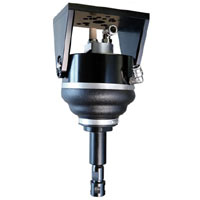While hand deburring is certainly successful with highly-trained individuals, the output is often far below what manufacturers need to meet their demand. Too often, hand deburring results in more part scraps and lack of inconsistency, which translates to lower quality products.
Robotic deburring can be highly cost-effective and consistent, yet finding the right robotic deburring tool can be challenging. Robots must be properly programmed to execute successful deburring, and there are certain factors to take into account when choosing the right tool.
Here are three tips to help you make the right decision when searching for robotic deburring tools for your automation needs!
Consider Part Geometry
The size, shape, weight, and complexity of your parts that need to be deburred is an essential consideration when looking for the right deburring device. Not every robotic deburring tool can successfully deburr parts of every shape.
The tool you choose will vary based on the location and size of the burrs and how well your tooling complies with the device—in other words, how well it consistently makes contact with and applies force to the part for successful deburring.
If your parts are complex and have tight spaces, you may need a radially compliant device. However, if your burrs are consistently on the edge of the product, axially compliant could be a better choice. It all depends on what your parts look like and how successful your tooling will be to remove burrs without compromising part quality.
Look for Variable Speed Options
Choosing variable speed deburring tools over fixed RPMs gives you greater flexibility. Variable speeds gives your tooling the ability to automatically adjust to part differences, which saves you time and effort on programming. Many different materials can be deburred with just one variable speed robotic deburring device.
Variable speed devices aren’t limited to burrs of a specific size and shape as fixed RPM models are. When deburring, the burr needs to be completely removed, but you don’t want to take off any more material than necessary, which can affect your part’s quality and function. This alone is difficult for many deburring robotic devices to accomplish.
Fortunately, variable speed gives you the flexibility you need for your parts to increase consistency while reducing programming efforts.
Consider Radially Compliant Deburring Tools
Axially compliant tools can be effective for specific applications such as edge deburring. However, for the majority of applications, parts and burrs aren’t consistent, which makes having a robotic deburring tool that can accommodate part and burr changes essential.
Radially compliant deburring tools easily accommodate changes without the need to manually reorient the robot, saving you time and effort. With radially compliant devices, manual deburring is mimicked, giving you consistent force and the ability to get into tighter areas.
With radially compliant deburring tools, you can also remove parting lines and flash, whereas axially compliant tools wouldn’t. Considering radial instead of axial for your deburring processes gives you a greater range of flexibility without sacrificing results.
Invest in the Right Deburring Tool
RAD’s Variable-Speed, Radially-Compliant OmniForce™ Deburring Tool easily adapts to part irregularities and reduces scrap, giving your machines maximum uptime with minimal programming. For consistent results with variable speeds, our deburring tools can successfully be used with your robot arms, gantry systems, cartesian robots, and can even be pedestal mounted to meet your automation needs. Find out more about our automatic deburring tools by contacting us at (937) 667-5705!


 The size and shape of the items you need your EOAT to manipulate and transport is a huge factor in your decision-making process. Parts of different shapes, sizes, and fragility have different considerations when it comes to your robotic tooling.
The size and shape of the items you need your EOAT to manipulate and transport is a huge factor in your decision-making process. Parts of different shapes, sizes, and fragility have different considerations when it comes to your robotic tooling. Designed to carry larger objects than 2-jaw grippers,
Designed to carry larger objects than 2-jaw grippers,  Collet grippers
Collet grippers